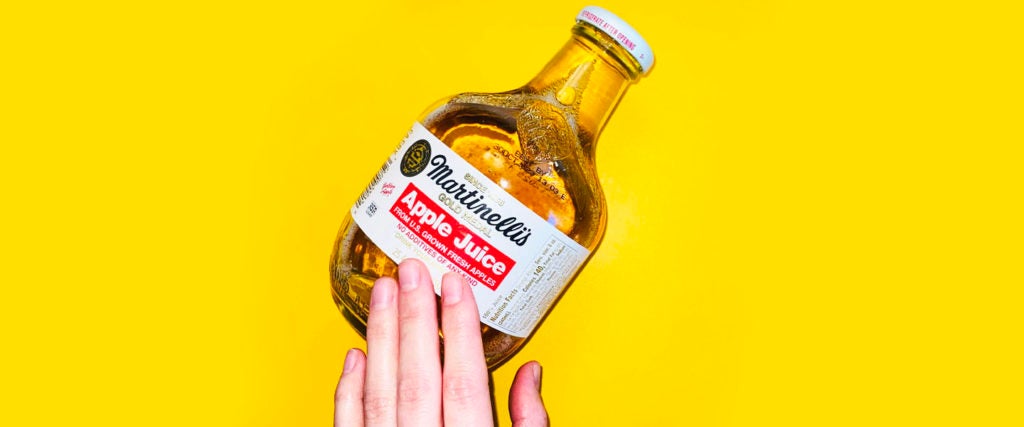Posited: This is the most reliably pleasing experience that’s available in the world as it exists now.
they did not have to make these so perfect. i would’ve settled for an apple juice that tasted less good. it could have come in a less pleasing bottle. but they do not fuck around over at martinellis pic.twitter.com/E5s6p3oABx
— rax ‘martinellis apple juice enthusiast’ king (@RaxKingIsDead) February 16, 2021
That right there is a teeny tiny bottle of Martinelli’s apple juice. And the pleasing experience of it isn’t just about drinking down the juice. No, sir! It’s about finding it unexpectedly in your corner store’s drink cooler, coughing up a little more money than you prefer to spend on such a small treat, holding that perfectly shaped bottle in your hand, and, yes, drinking the juice, which is uncommonly tasty.
This praise shouldn’t come as a surprise. I am firmly on the record as a dedicated Martinelli’s fan. I was surprised to tweet about the brand and find so many other devotees. People may drink more Coke and Pepsi, but they drink it because it’s there, not because they adore it. When people chug these little bottles, they universally do so out of love. In a way, it’s the inverse of the mall food principle: Mall food smells so tempting that it can be nothing but a disappointment upon consumption. A friendly little bottle of Martinelli’s is unassuming, not flashy nor seductive in any way, but incomparably delicious.
But plenty of things in this world are tasty or cute or both without being so universally cherished by their stans. Why, then, do we love Martinelli’s so much?
One theory: The brand is big enough to have a national presence and therefore able to gather plenty of adherents. But it still reads as small to us in an enticing way. To this day, the company is owned by descendants of its founders, an appealing fact that the brand has cannily embraced, stamping every bottle of apple juice with an unobtrusive reminder that the brand was founded in 1868. As consumers, we appreciate the romance of a 150-year-old apple juice family. In a similarly romantic vein, we also appreciate the reminder on every bottle that the juice within is made from “U.S. grown fresh” apples.
Now, I’m agnostic about whether that latter statement is especially meaningful. FDA regulations for the word “fresh” still allow for the presence of pesticides, the use of which Martinelli’s has claimed to reduce but not abandon outright. And “U.S. grown” doesn’t tell us anything about the labor conditions that all those proud American apples are grown under. But other brands are guilty of much shadier and more overtly harmful messaging, and my point isn’t that Martinelli’s marketing is saintly in its goals — just that it’s cohesively romantic.
For what it’s worth, that romantic messaging does map onto some real benefits in the way the juice is manufactured. Martinelli’s is one of few national apple juice brands that’s not made from concentrate, and it contains only the sugar that’s naturally in its apples. According to public relations director Sue Kennedy, the brand is committed to sustainable farming practices (including the owl boxes linked to above), though the details its website offers on its environmentally friendly practices include fuzzy ones like “conserve fossil fuels by promoting biking to work.” So it comes by some of its romanticism honestly, but much of it lives strictly in our heads as consumers, which is probably what any drinker who knows anything about advertising would expect.
One other angle to the widely shared love for Martinelli’s: It’s a really tasty non-alcoholic drink. This sounds stupefyingly obvious, but it matters in a bigger way than you’d think. Consider how many occasions are attended by the consumption of alcohol, a consumption that feels unobtrusive until you want to avoid it. What is New Year’s without a glass of champagne? What’s a seder without wine?
Plenty of drinks don’t contain alcohol, of course, but not plenty of delicious ones. Most big-label sodas are just there; they don’t taste any particularly exciting way, but you can find them at any 7-Eleven, so you remain loyal to them just because. Orange juice is marred by its unavoidable association with breakfast, and feels weird to drink at 7 p.m. Iced tea is caffeinated, which means that even people who like it often can’t drink it at night. Smoothies, frankly, are a gross waste of fruit. That’s not an opinion, that’s one of God’s own facts. And even other apple juices are often packed to the gills with sugar.
Martinelli’s, however, is an adult-friendly drink that doesn’t look out of place at a bar or party. The glass bottle isn’t only more environmentally friendly than a plastic one, but also has the boon of seeming grown-up and sophisticated. These considerations may not seem important, but when you’re sober and looking to celebrate an adult occasion with adult provisions, they matter. If you go for a large bottle of Martinelli’s sparkling cider, you’ll find it indistinguishable from champagne unless you squint at the label.
Fun fact: Martinelli’s place of honor among sober people dates back to the 1920s. Until then, Martinelli’s sold a line of alcoholic drinks that they were forced to abandon with the onset of Prohibition. They ditched the champagne itself but kept the champagne-style packaging.
Speaking of that packaging, one weird and unexplainable element of this apple juice’s appeal is that fat little bottle it comes in. Several people replied to my tweet that the bottle is potion-like; it looks like something you’d chug in a video game to refill your health bar. And it turns out that, too, is a holdover. The shape, according to Kennedy, is meant to resemble a golden apple, and was released in 1933 alongside the slogan “Drink Your Apple a Day.” Listen, I know it’s 2021 and we all have desperate advertisement fatigue, but that’s cute and I won’t pretend it’s not.
More than any individual element that can be attributed to the juice’s recipe or branding, though, the reason we love this stuff so much has to be that it’s always a thrill. When do you drink a little bottle of apple juice? At recess, or after giving blood, or because you saw it in the convenience store’s beverage fridge and decided to treat yourself. It’s never something you need to force down, the way even foods we love can be if we’re sick of them. You don’t drink it often enough to get sick of it, but you don’t find it so infrequently that it’s a rare pleasure. What it is, precisely, is a treat — one that’s essentially optimized for maximum pleasantness in every element of its design.

